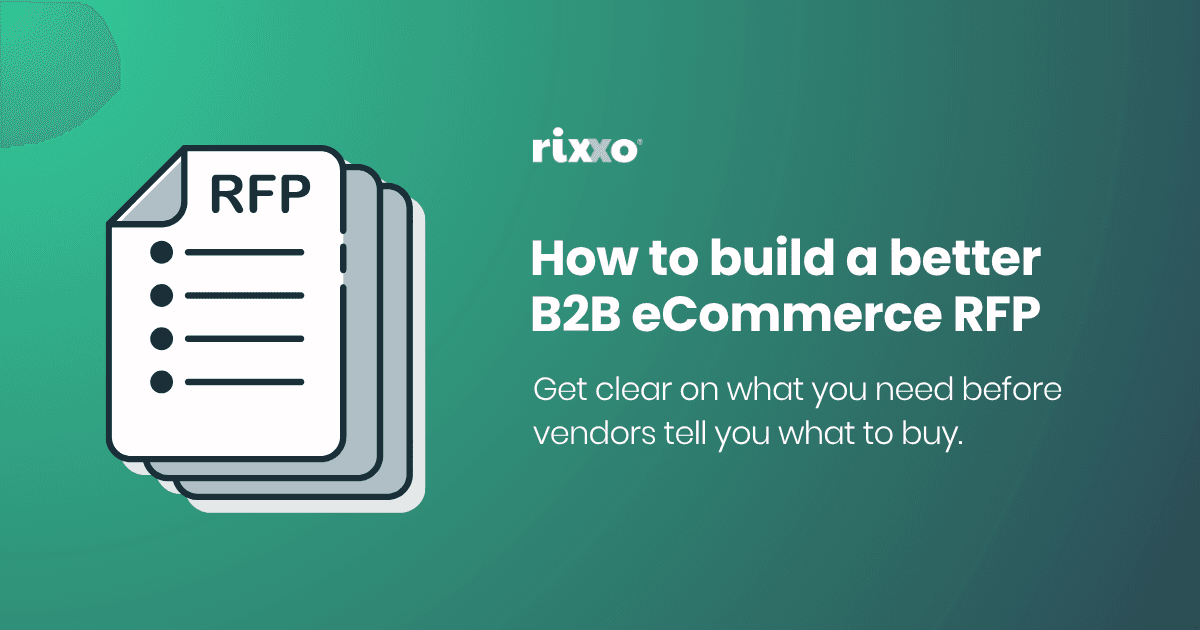How to build a better B2B eCommerce RFP (And why needs come first)


Stop chasing features. Start with your needs.
Most B2B platform projects go sideways before they even get started.
Someone suggests comparing a few vendors. Someone else books a demo. A spreadsheet shows up. Before long, you’re deep in feature lists and marketing slides, trying to figure out which platform is “best.”
Here’s the problem: best doesn’t exist. Not without your story.
Until you’re clear on how your business works, and what actually needs to change, you’re just guessing. And those guesses cost money. You end up with a platform that looks good on paper, but doesn’t fit in practice. More workarounds. More frustration. Less return.
That’s why we built something different.


Our RFP template helps you get clear on what matters before you speak to a single vendor. It’s practical. It’s built for B2B. And it helps you stop shopping blind.


Our RFP template helps you get clear on what matters before you speak to a single vendor.
It’s practical. It’s built for B2B. And it helps you stop shopping blind.
Why most RFPs don’t work
A team grabs a template from the internet. They dump in a few hundred features. Then they send it off and ask three platforms to tick yes or no.
That’s not an RFP. That’s a feature bingo card.
You can’t pick the right platform if all you’ve done is list what might be nice to have. Here’s what usually happens next:
- You chase shiny features that never get used
- You forget the things your team actually needs
- You assume “out of the box” means ready to go
- You burn time building workarounds
- You swap one set of problems for another
All because the brief never actually described how your business runs, or what outcomes you were trying to get to.
The fix: a framework that puts your needs first
We use a framework called SPIN APE to build proper RFPs, the kind that get taken seriously, save time, and lead to better decisions.
It was originally a sales method. Platforms use it to sell to you. We flip it, so you’re the one in control.
Here’s how it works.
SPIN
Situation
What’s going on in your business right now? What systems are in place? Who’s involved? What’s working, what’s not?
Problem
What’s slowing you down? Where are the bottlenecks, the manual processes, the pain?
Implication
What happens if that doesn’t change? What does it cost you — in time, money, lost sales, wasted effort?
Need
What outcomes do you actually need from this platform? Not “we want advanced reporting.” More like “we need sales and customer service looking at the same order data.”
APE
Align
Get your internal people on the same page. Everyone affected by this platform — sales, ops, support, finance — should have input before the brief goes out.
Propose
Send your needs to vendors and let them respond with how they’d solve the problem. Give them room to show how they’d actually deliver, not just tick boxes.
Evaluate
Score each response based on three things:
- Business value: How much impact will this have?
- Effort: How hard will it be to build?
- Confidence: Did they get it? Did they respond clearly, or did it feel like pulling teeth?
This way, you’re not picking the slickest demo. You’re picking the platform that fits.
Build clarity before you build anything else
SPIN APE does more than just improve your brief. It gives you a clearer view of your business.
It shows you:
- Where you’re strong
- Where you’re stuck
- Who needs to be involved
- What success actually looks like
It helps teams align. It uncovers gaps. It builds shared understanding. And when you finally do go to market, you’re not hoping, you’re leading.
Clarity cut costs for this wholesaler
A wholesaler we worked with had 25 reps taking orders over the phone. Every rep had a Sage licence, costing £200 a month, just to key in sales manually. That’s £5,000 a month on data entry. And customers still had to call back to check their orders.
The internal chaos was worse. Sales could override prices without approval. Orders were getting stopped for manual checks. The eCommerce site was live, but barely used. It wasn’t relieving any pressure, just adding another system to the pile.
When we stepped in, we didn’t start with features. We started with what actually needed to change.
- Sales needed to create quotes faster
- Customers needed to track their own orders
- The business needed control over pricing and process
That shift in focus, from platform to problem, saved them thousands a month in licence fees alone. More importantly, it gave them back control.
Start with your story
You don’t need a generic platform that ticks off a feature list.
That means starting with how your business runs, not what the vendor wants to show you. Your real needs. Your real blockers. The things that drive value day-to-day.
That’s what this RFP template is built to uncover. It gives you structure. It brings your team together. It saves time and money. And it leads to better decisions, because it starts with you, not the tech.


Our RFP template helps you get clear on what matters before you speak to a single vendor.
It’s practical. It’s built for B2B. And it helps you stop shopping blind.
